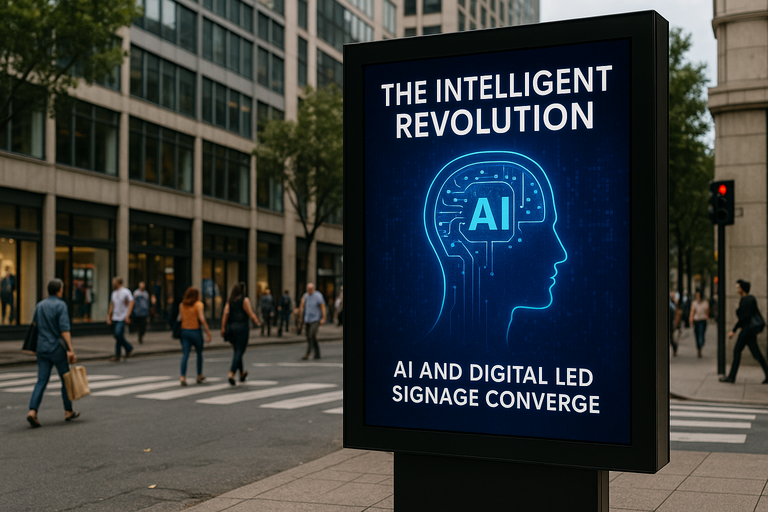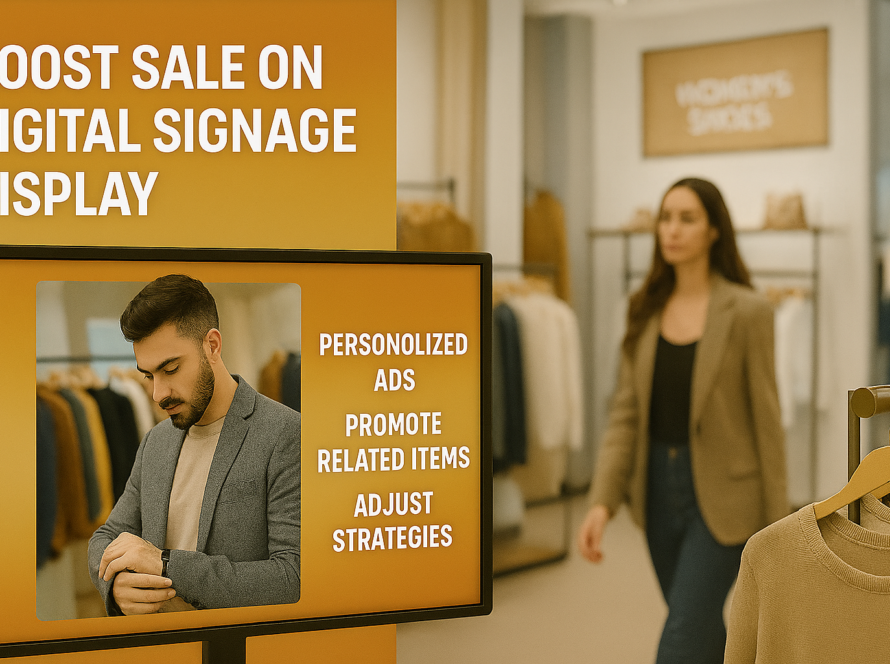AI-Powered Retail Store Digital Signage: Intelligent, Privacy-First Displays That Drive Sales
Digital signage has long been a staple of retail, replacing static posters with vivid screens and instant updates. Today, the best retail store digital signage systems fuse artificial intelligence (AI) with measured hardware, turning screens into adaptive marketing channels that show the right content to the right shopper at the right moment.
The intelligent future of retail store digital signage
Retail store digital signage is evolving from scheduled playlists to context-aware systems that respond to audience and environment signals. AI-driven platforms use anonymous video analytics, weather feeds, POS and inventory data, and local events to make real-time content decisions that increase relevance and reduce wasted impressions.
Small retailers and national chains alike can now deploy cloud-hosted solutions that automate content selection, schedule changes and generate creative assets. If you want to explore the platform capabilities referenced here, start with our Free Digital Signage | Australia’s AI-Powered Display Platform.
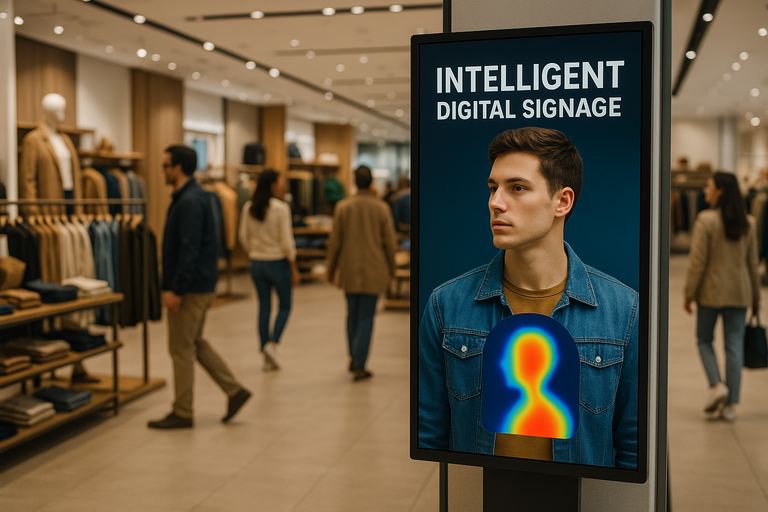
AI use cases for retail store digital signage
AI unlocks measurable use cases for retail store digital signage. Below are common deployments that deliver measurable outcomes when they’re implemented with clear goals and analytics.
1. Real-time personalisation
Displays select content based on anonymous audience attributes (e.g. age group or group size) and contextual triggers. No personally identifiable data is stored unless customers explicitly opt in via a loyalty app.
2. Dynamic content optimisation
AI A/B tests creative variations, learns what captures attention and shifts playlists to maximise dwell time and conversion. This continuous optimisation reduces wasted impressions and improves overall campaign efficiency.
3. Inventory & environment integration
Digital signage can subscribe to inventory APIs and POS. When a featured SKU is low, the screen promotes alternatives. Weather and local events also become triggers for promotional swaps.
4. Customer journey mapping
Combine in-store sensors and mobile opt-ins for a holistic journey: entrance displays set the tone, aisle-mounted screens influence consideration, and checkout screens capture last-minute upsells.
See industry examples and use cases at Find the Best Digital Signage Solutions for Your Industry.
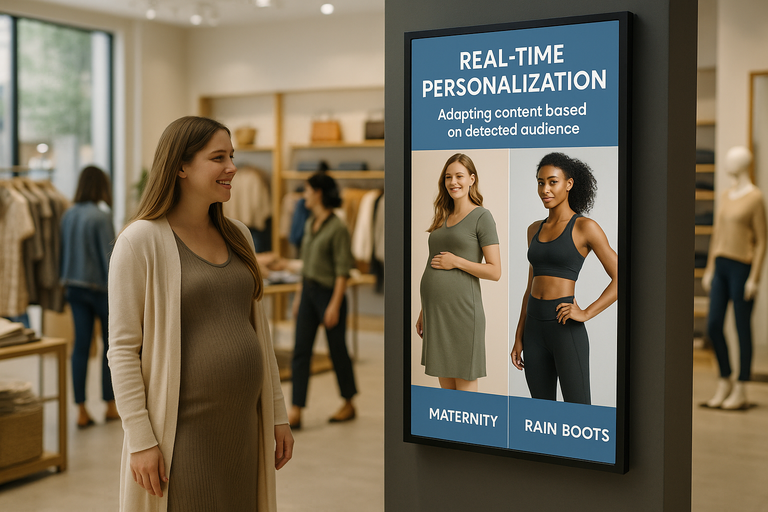
Trends reshaping retail store digital signage
Key trends that retailers should monitor:
- Generative content: on-demand visuals and copy variants reduce creative spend and keep displays fresh.
- Predictive analytics: anticipate peak periods and schedule promotions proactively.
- Conversational & interactive screens: natural language, touch and gesture create guided experiences.
- Edge AI: local processing for low-latency analytics and privacy-friendly anonymisation.
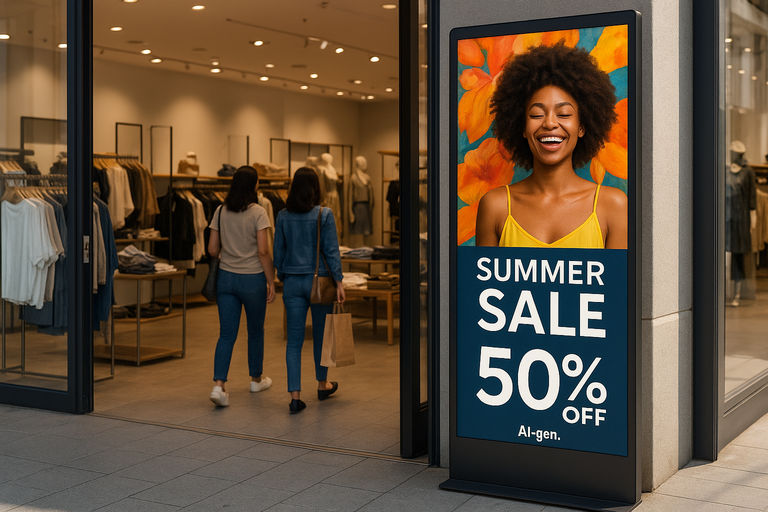
Real-world example: data-driven signage in action
Case studies show AI-driven playlists perform better when they are tied to measurable KPIs. For example, a supermarket that connected displays to weather and POS data prioritised cold beverages during heat spikes and increased conversion at entrances; a fashion store used attention heatmaps to relocate screens and lift accessory cross-sells.
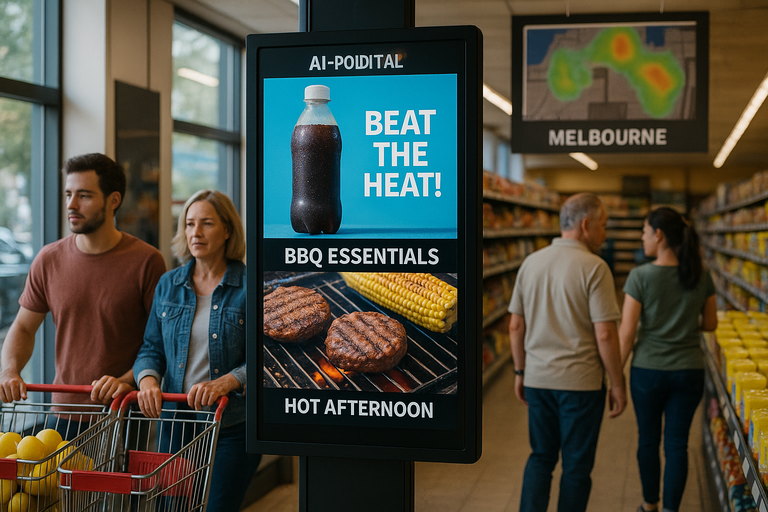
Ethical, privacy-first retail store digital signage
Responsible AI and compliance are mandatory. Practical safeguards for retail store digital signage include:
- On-device analytics (edge processing) and no persistent image storage by default.
- Clear signage and customer notices explaining anonymised analytics and opt-in personalisation via loyalty apps or SMS.
- Data minimisation and retention policies (short windows for aggregate metrics, e.g. 24–90 days depending on use).
Privacy & compliance: APPs (AU), GDPR, CCPA
Deployments that use cameras or behavioural data must observe regional privacy frameworks.
- Australia — APPs: follow the Australian Privacy Principles. Ensure transparency, purpose limitation and secure handling of any personal data.
- EU — GDPR: use lawful bases (consent or legitimate interest), perform Data Protection Impact Assessments (DPIAs) for audience analytics, and enable data subject rights.
- US — CCPA/CPRA: provide opt-out mechanisms and disclosure of sales/sharing of personal data; consider de-identification standards to reduce obligations.
Best practice: process analytics as aggregated, anonymised events. If personalisation is offered, use explicit opt-in with logged consent, and isolate PII from analytics streams.
Specs that matter for retail store digital signage
Recommended hardware specs by environment:
- Indoor screens: 350–700 nits brightness, commercial-grade LCD/LED, 3–5 years warranty, portrait and landscape support.
- Window-facing / high-ambient light: 2,000–5,500 nits or direct-view LED; anti-reflective glass.
- Outdoor LED walls: IP65-rated enclosures, pixel pitch 6–10 mm for distance viewing, brightness 3,500–6,500 nits.
- Pixel pitch guidance: Indoor LED 1.2–2.5 mm (close viewing), Outdoor LED 6–10 mm (distance viewing).
- Player (edge AI): For basic playback — quad-core ARM or Atom class with 2–4GB RAM; for edge analytics — Intel i5 / ARM Cortex-A78AE or better, 8–16GB RAM, 64–256GB SSD, optional GPU acceleration (e.g. NVIDIA Jetson/Intel NPU) if running on-device models.
- Network: 5–20 Mbps per video stream for multi-screen HD; real-time analytics require reliable low-latency links and VPN for secure management.
- Operational: 24/7 rated displays, MTBF >50,000 hours, commercial warranty 3–5 years, remote monitoring and alerting SLA.
Measurement & ROI for retail store digital signage
Define KPIs before launch and instrument measurement from day one.
- Attention metrics: dwell time, look-through rate, attention time per creative.
- Conversion metrics: link POS sales uplift to campaign windows; measure average transaction value and attach rate.
- Engagement metrics: QR scans, coupon redemptions, app opt-ins and interactive session counts.
- Operational metrics: uptime, player health, time-to-fix.
Simple ROI formula (example): Sales lift (%) = (Sales during campaign − baseline sales) ÷ baseline sales × 100. Use A/B tests (different creatives, time slots, or placements) and POS integration to validate causation.
Implementation checklist: launch retail store digital signage with confidence
Hardware
- Choose commercial-grade displays (match brightness and pixel pitch to location).
- Select media players with appropriate CPU/GPU for your analytics needs.
- Confirm mounting, power, and ventilation requirements (portrait vs landscape).
Software & integrations
- Cloud CMS with playlist automation and template library — check Features – Sign Inspire for attention metrics and heatmaps.
- POS and inventory integration for real-time offers.
- Analytics pipeline and BI dashboards; set data retention and anonymisation rules.
Operations
- Device activation, remote monitoring and alerting (SLA).
- Privacy notices, opt-in flows and DPIA if required.
- Staff training and content calendar ownership.
Need a simple installation guide? Follow Digital Signage Installation Made Easy to get started in minutes.
Emerging trends to watch
- Generative AI creative engines: produce dozens of on-brand creative variations instantly — see Elevate Your Digital Signage with AI-Driven Expanded Images.
- Conversational screens: voice and chat-driven wayfinding and product assistants.
- Robotics & phygital: robots and kiosks that combine movement with nearby displays for immersive experiences.
- Federated & edge learning: improve models without centralising PII — great for privacy-sensitive deployments.
Implementation timeline (typical)
- Week 0–2: Site survey, hardware procurement and network readiness.
- Week 3–4: Media player provisioning, CMS set up, template creation.
- Week 5: Pilot run in 1–3 stores; collect metrics and refine creatives.
- Week 6–12: Rollout with remote monitoring and A/B testing cadence.
FAQs
Q: What is the difference between retail store digital signage and a regular TV?
A: A retail store digital signage system includes a cloud CMS, scheduling, remote device management and commercial-grade hardware designed for 24/7 operation. Consumer TVs usually lack remote orchestration and commercial warranties.
Q: How does AI protect customer privacy with retail store digital signage?
A: Reputable solutions use on-device anonymous analytics, process data in real time without storing images, retain only aggregated metrics, and provide opt-in flows for any personalised experiences linked to loyalty programs.
Q: What specs should I choose for an LED retail window display?
A: For window-facing retail displays, choose 2,000–5,500 nits brightness or direct-view LED with IP65-rated enclosures for outdoor installations and a pixel pitch chosen for typical viewer distance (6–10 mm for outdoor).
Q: How do I measure ROI from digital signage in-store?
A: Integrate POS timestamps with CMS schedules, run A/B tests, and track KPIs like dwell time, conversion rate and average transaction value to quantify lift against baseline periods.
Compliance notes & recommended policies
Before deployment, document the following and publish them where customers can easily find them:
- Privacy notice describing what is collected, processing purpose, retention period and opt-outs.
- Data minimisation policy: only store aggregated metrics and keep raw footage off unless explicit consent is granted.
- Security controls: encryption in transit and at rest, role-based access control, logging and audit trails.
Next steps & resources
Ready to pilot AI-powered retail store digital signage? Start small: pick one high-impact location, connect POS, run a four-week pilot and measure uplift. If you need templates or inspiration for creative and placement, our practical guide on In Store Digital Display: How to Maximise Its Impact contains placement tips, examples and quick wins.
For industry-specific examples, content automation and enterprise features visit Solutions and review the platform Features – Sign Inspire.
Conclusion: retail store digital signage as a competitive advantage
The intersection of AI and retail store digital signage offers a practical, measurable route to improved engagement, operational efficiency and incremental sales. Prioritise privacy-first analytics, choose the right specs for each location, instrument POS integration from the start and iterate using A/B testing. With careful implementation, digital signage becomes more than a screen: it becomes a smart retail channel that learns and improves over time.

